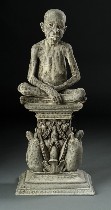
When I stopped into Wexler Gallery last week, gallerist Bobbie Ann Tilkens told me that the paintings upstairs by Katey Cooper were part of a plan, not yet written in stone, to make 2-D art a regular feature upstairs, perhaps every two months. I failed to ask if local artists would be on the agenda or not, but I got the sense the plan is still evolving.
 What brought me to Wexler in the first place were the ceramic sculptures by Dirk Staschke, who’s all of 33 years old and is fired up about the state of the nation. His work, beautifully formed figures about subjects like starvation in the land of excess, the pressure to conform and go along with the program, or deterioration in the land of excess sometimes tips into hardcore polemics, but given his subject matter, that’s no surprise.
What brought me to Wexler in the first place were the ceramic sculptures by Dirk Staschke, who’s all of 33 years old and is fired up about the state of the nation. His work, beautifully formed figures about subjects like starvation in the land of excess, the pressure to conform and go along with the program, or deterioration in the land of excess sometimes tips into hardcore polemics, but given his subject matter, that’s no surprise.
The surprise is in the melding of classical technique and classical iconography to communicate these kinds of thoughts.
And where the pieces work, they work really well. My favorite was “Baroque 2” (shown top), the Buddha pose of the starving boy suggesting endurance and unreasonable expectations of society all at once. I also admired the stance of Baroque 3 (shown next), with its swayback and distended belly beneath prominent ribs.
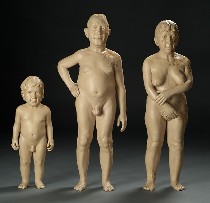 The other series I found interesting was “Entropic Family,” slightly dorky people with modern, doughy bodies and faces, parts of them destroyed by application of a blow torch. The resulting, uncontrolled explosions of the clay leave the figures pocked with holes and dents.
The other series I found interesting was “Entropic Family,” slightly dorky people with modern, doughy bodies and faces, parts of them destroyed by application of a blow torch. The resulting, uncontrolled explosions of the clay leave the figures pocked with holes and dents.
The strength of these pieces is they don’t trumpet their content, other than the inevitability destruction and erosion–of the human body and of ceramic pieces.
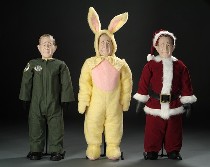 The pieces that brought me to Wexler in the first place, three George Bush figures, costumed as the Easter Bunny, Santa, and an army aviator, were beautifully done, but ultimately, felt like a one-note joke, too thin to sustain long-term interest.
The pieces that brought me to Wexler in the first place, three George Bush figures, costumed as the Easter Bunny, Santa, and an army aviator, were beautifully done, but ultimately, felt like a one-note joke, too thin to sustain long-term interest.
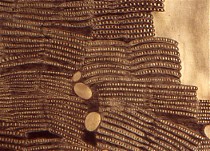 Upstairs, “Ovals,” a show of gold-leaf-and-black paintings by Cooper (left, “Muscle Building” detail), suggested a religious, meditative process in their creation–a process reminiscent of some early work I saw from Diane Pieri, then at More Gallery, many years ago, gold gouache symbols repeated over and over again in rows on blue fabric.
Upstairs, “Ovals,” a show of gold-leaf-and-black paintings by Cooper (left, “Muscle Building” detail), suggested a religious, meditative process in their creation–a process reminiscent of some early work I saw from Diane Pieri, then at More Gallery, many years ago, gold gouache symbols repeated over and over again in rows on blue fabric.
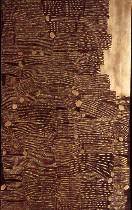 Besides Cooper’s repetitive forms, mostly cellular and oval, that suggest a trancelike focus in their creation, the gold leaf pumps up a religious allusion to icons.
Besides Cooper’s repetitive forms, mostly cellular and oval, that suggest a trancelike focus in their creation, the gold leaf pumps up a religious allusion to icons.
This being spring and Easter weekend, the cell-like ovals felt just right (right, “Muscle Building”). The gold leaf is sometimes washed over with color to change its strength and sometimes to add points of interest, but the overall impression is gold.
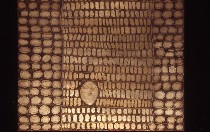
The strongest of these works are quite beautiful (right, “Duct”); a few of them veered toward decorative. All of them feel opulent and crowded with life and riches. But if Bush the Easter Bunny hid them for me somewhere in my house, I wouldn’t complain.









